Corporate group rationalisation: how to save costs and achieve operational efficiencies

09 February 2021 | EMEA 11AM GMT | Americas 1PM EST
Corporate groups can become unwieldy and inefficient over time. In many cases, they accumulate structures that are no longer fit for purpose, use up valuable time and resources, and ultimately affect operational efficiency.
Most CFOs and other senior executives of multinational organisations are familiar with the potential benefits of corporate group rationalisations. In a recent survey conducted by Vistra and CFO Magazine, 61 percent of respondents said their organisations were currently involved in or considering some form of corporate group rationalisation. Their top two reasons were to cut back on costs related to entity maintenance and the desire to simplify their corporate structures.
Corporate group rationalisation, or entity rationalisation, provides businesses with an opportunity to build more efficient and sustainable operating structures, improve operational transparency and significantly reduce the costs and risks associated with maintaining inefficient and needlessly complex organisational structures. It’s also an excellent opportunity to align a company’s organisational structure with its corporate strategy and current market realities. In particular, organisations that have recently completed or are considering engaging in M&A activity have greater opportunity to benefit from conducting a corporate group rationalisation.
This webinar is designed to help you better understand the process of conducting a corporate group rationalisation. Our experts will discuss:
- Potential benefits of a corporate group rationalisation and why it’s important
- Things to consider before you begin
- Pitfalls to avoid
- What is involved – step by step process
- Important legal, tax, governance and HR considerations
- Case studies
Presenty by:

The contents of this article are intended for informational purposes only. The article should not be relied on as legal or other professional advice. Neither Vistra Group Holding S.A. nor any of its group companies, subsidiaries or affiliates accept responsibility for any loss occasioned by actions taken or refrained from as a result of reading or otherwise consuming this article. For details, read our Legal and Regulatory notice at: https://www.vistra.com/notices . Copyright © 2024 by Vistra Group Holdings SA. All Rights Reserved.



